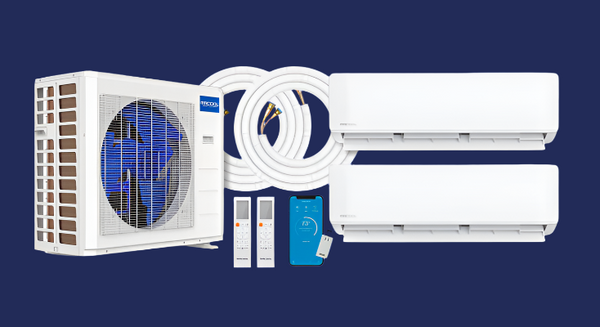Understanding the Differences: Split System HVAC vs. Packaged Systems
When choosing an HVAC system for your home or business, two of the most common options are split systems and packaged systems. While both provide heating and cooling, they differ significantly in installation, efficiency, space requirements, and maintenance.
In this guide, we’ll break down the key differences, benefits, and drawbacks of split system HVACs to help you decide if they’re the right fit for your needs.
🔹 What is a Split System HVAC?
A split system HVAC consists of two main components:
✔️ An outdoor unit – Contains the compressor and condenser
✔️ An indoor unit – Houses the evaporator coil and air handler/furnace
These units are connected via refrigerant lines, electrical wiring, and drainage pipes to work together efficiently. Unlike packaged systems, which house all components in one outdoor unit, split systems separate the heating and cooling components, offering greater flexibility and efficiency.
🔹 Benefits of a Split System HVAC
✔️ 1. Higher Energy Efficiency 🔋
✅ Optimized component performance – Each unit works independently for better efficiency.
✅ Higher SEER ratings – Many split systems offer 16+ SEER, reducing energy costs.
✅ Less energy loss – Compared to packaged units, less heat is lost in ductwork, improving performance.
💡 Why it matters: If energy savings and a lower carbon footprint are priorities, a split system HVAC is a great option.
✔️ 2. Flexible Installation 🏡
✅ Works in multi-story homes & complex layouts
✅ Customizable placement – Indoor units can be wall-mounted, ceiling-recessed, or installed in closets/attics.
✅ Easier ductwork integration – Suitable for existing homes & new construction
💡 Why it matters: If you have limited outdoor space or need zoned cooling/heating, a split system adapts to your home’s layout better than a packaged system.
✔️ 3. Quiet Indoor Operation 🤫
✅ Noisy compressor stays outside – The indoor unit remains whisper-quiet.
✅ Great for bedrooms, offices, & living rooms – Reduces indoor noise pollution.
💡 Why it matters: If you want a peaceful home environment, a split system HVAC is the way to go.
✔️ 4. Space-Saving & Aesthetic Appeal 🎨
✅ Indoor units are sleek & compact – Easily blend into modern décor.
✅ No bulky equipment inside – No need for an indoor furnace in small homes.
✅ More flexible outdoor placement – Outdoor unit can be installed discreetly.
💡 Why it matters: If space is limited indoors, a split system frees up room for storage or living areas.
🔹 Drawbacks of Split System HVACs
⚠️ 1. More Complex Installation 🔧
❌ Requires refrigerant line connections – Must be properly installed for optimal performance.
❌ Ductwork may need modifications – Older homes may need duct upgrades.
❌ Higher labor costs – Installation takes longer than a packaged unit.
💡 Solution: Hire an experienced HVAC technician to ensure a smooth installation.
⚠️ 2. Higher Upfront Cost 💰
❌ Split systems are generally more expensive than packaged units.
❌ Professional installation adds to the cost.
💡 Solution: The long-term energy savings typically outweigh the higher upfront investment. Look for rebates & incentives on energy-efficient models.
⚠️ 3. More Maintenance Required 🛠️
❌ Two units = More maintenance – Both indoor & outdoor units need servicing.
❌ Filters, coils, & refrigerant levels must be checked regularly.
💡 Solution: Schedule annual HVAC tune-ups to prevent costly breakdowns.
⚠️ 4. Outdoor Unit Visibility 🚪
❌ Outdoor unit can be bulky & noticeable.
❌ May not be ideal for homes with limited exterior space.
💡 Solution: Install the outdoor unit behind landscaping or fencing to reduce its visibility.
🔹 Split System vs. Packaged Unit: Key Differences
| Feature | Split System HVAC | Packaged Unit |
|---|---|---|
| Components | Separate indoor & outdoor units | All-in-one outdoor unit |
| Space Requirement | Requires indoor space for air handler | No indoor space required |
| Energy Efficiency | ✅ Higher SEER ratings | ⚠️ Slightly lower efficiency |
| Installation Complexity | ⚠️ More complex – Requires refrigerant lines | ✅ Easier setup |
| Maintenance | Both units need servicing | All components in one location |
| Noise Levels | ✅ Quieter indoors – Compressor is outside | ⚠️ May be louder indoors |
| Aesthetic Impact | ✅ Sleek indoor design | ⚠️ Bulky outdoor unit |
| Best For | Homes needing flexible zoning & energy efficiency | Homes with limited indoor space |
🔹 Which HVAC System is Right for You?
Choose a Split System HVAC if:
✔️ Energy efficiency is your top priority
✔️ You want quieter indoor operation
✔️ You need flexible installation for a multi-story home
✔️ You prefer a sleek indoor design
Choose a Packaged Unit if:
✔️ You have limited indoor space and need all components outside
✔️ You want a simple, all-in-one system
✔️ You need fast, lower-cost installation
🔹 Conclusion: The Best System for Your Needs
A split system HVAC is ideal for homeowners prioritizing energy savings, quiet performance, and flexible installation. While the initial investment is higher, the long-term efficiency & customization benefits make it a smart choice.
For small homes, mobile homes, or commercial buildings, a packaged unit may be the better solution due to its compact, all-in-one design.
🚀 Ready to upgrade your HVAC system? Find high-efficiency split systems & packaged units at www.mrcooldiydirect.com for reliable heating & cooling solutions! ❄️🔥





